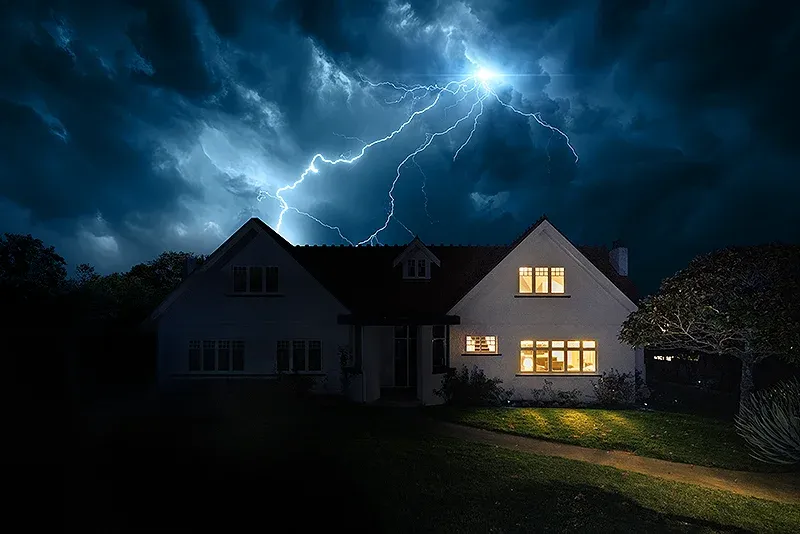Choosing house insurance that can weather the storm
By MAS Team
The climate in Aotearoa New Zealand is changing. We’re facing the prospect of more extreme temperatures, more destructive winds and more rainfall more often. Severe weather events can increase the strain on our infrastructure, creating a greater risk of property damage. With this increased risk, it may be time to reassess your house insurance to ensure it meets your expectations.

For a number of years, 'unprecedented' was the go-to word to describe shocking weather occurrences, things we’ve never seen before or that were completely unexpected. ‘Unprecedented’ was used almost on repeat to describe the extreme weather event we now call the Auckland Anniversary Weekend floods. In the 2 years since, other weather-related terms, like marine heatwave, atmospheric river, and weather bomb, have entered our daily newsfeeds, showing how common extreme weather is becoming.
Natural events leave scars, and for many, the ripples are felt for years afterwards. Sometimes, people and property are changed forever. Adding to the lasting effects, exposed to natural disaster events, inflation and rising building costs, many insurance companies have been moving away from Full Area Replacement in favour of Sum Insured policies.
Sum Insured is an agreed value policy. It provides a maximum dollar amount, proposed by the homeowner and agreed by the insurer, based on the estimated cost to rebuild or repair the home if it's damaged or destroyed.
It puts the onus on the homeowner to undertake the research required to make sure the insured value will cover replacement costs, which can be difficult to get right.
The alternative to Sum Insured (also called Agreed Value) is Area Replacement. This is where the insurer agrees to rebuild the home to the same size and standard it was before the loss. There's no fixed dollar cap, and you’re covered for the reasonable costs of a full rebuild. That's why Area Replacement Insurance is also often known as Full Area Replacement or Full Replacement Insurance.
The critical decision with a Sum Insured policy is choosing the amount of cover. The amount of cover is agreed at the time the policy is created. It’s based on a rebuild estimate at the time the policy was taken out and doesn’t account for any changes in building costs that may happen later.
The rising cost of construction has made headlines in recent years. Combined with a period of high inflation, this means homeowners with Sum Insured policies can be at risk of being underinsured.
With Full Area Replacement insurance, there is no fixed dollar cap. You're covered for the reasonable costs of a full rebuild. You can be confident your home will be fully replaced to the same square meterage and condition as it was before the loss. That’s great peace of mind.
In recent years, many insurance companies have moved to Sum Insured. At MAS, we’re bucking the trend. As a New Zealand-owned insurance and investments mutual, we help protect what matters most with trusted insurance solutions, and in most cases offer Area Replacement insurance as standard.
MAS is a mutual company, which means we’re owned by our Members, and our insurance policies are created with Members' best interests at heart. Combined with our exceptional service and claims experience, MAS Members have voted us Consumer People's Choice for 9 years in a row for House, Contents and Car insurance.
Unlike some other insurers, MAS has a comprehensive Area Replacement policy that provides a full rebuild for all damage, including in the event of fire or resulting from natural hazards.
There’s no one-size-fits-all answer. The best insurance for you will depend on your property, its location, and the complexity of the rebuild.
In some cases, Sum Insured will be useful for homes with unique features or partial rebuild plans, but that benefit will need to be weighed against the risk of underinsurance if rebuild costs rise or the estimate is inaccurate.
Full Area Replacement insurance gives the homeowner greater peace of mind that if the house is a total loss, we’ll pay the reasonable costs to rebuild their home to the same floor area as in the policy schedule.
You can learn more about Full Area Replacement insurance or get an estimate to help guide your decision.
This article provides general information only and is not intended to constitute financial advice. Before taking out any insurance product, you should carefully consider the terms and specific policy wording. Underwriting criteria will apply.

This guide explains why writing a will is important, how to write a will in New Zealand, what to consider when writing a will and how a will can be challenged.

There are a lot of options and exclusions in different life insurance policies from different providers, so it’s important to do your research and find a policy that’s right for you.

When it comes to safeguarding our possessions and financial security, the importance of contents insurance shouldn’t be overstated.